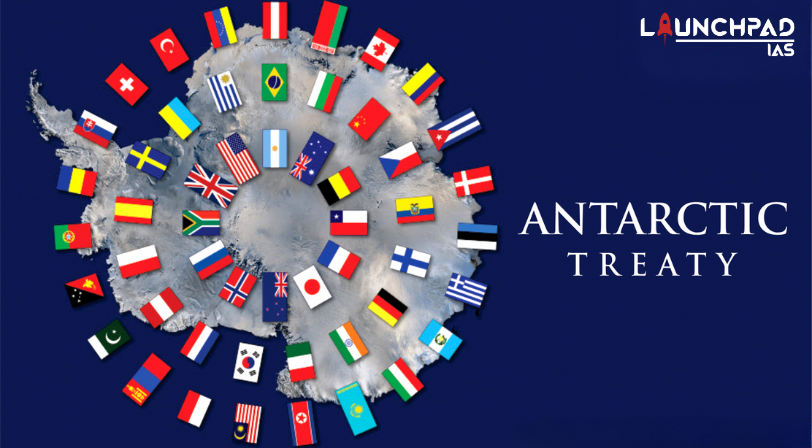History
- The Antarctic Treaty was signed between 12 countries in Washington on 1st December 1959 to make the Antarctic Continent a demilitarized zone to be preserved for scientific research only.
- The twelve original signatories are Argentina, Australia, Belgium, Chile, France, Japan, New Zealand, Norway, South Africa, the Union of Soviet Socialist Republics, the UK and the US.
- It entered into force in 1961 and has since been acceded by many other nations.
- Antarctica is defined as all of the land and ice shelves south of 60°S latitude.
- Recently, an enormous iceberg ‘A-76’ has calved from the western side of the Ronne Ice Shelf, lying in the Weddell Sea, in Antarctica.
Members
Currently, the Antarctic Treaty has 54 parties. India became a member of this treaty in 1983.
Headquarters
The Headquarters of the Antarctic Treaty is in Buenos Aires, Argentina.
Major Provisions of the Antarctic Treaty
- Promoting the freedom of scientific research.
- Countries can use the continent only for peaceful purposes.
- Prohibition of military activities, nuclear tests, and the disposal of radioactive waste.
- Neutralizing territorial sovereignty means a limit was placed on making any new claim or enlargement of an existing claim.
- It put a freeze on any disputes between claimants over their territories on the continent.
Dispute & Resolution
- There have been tensions from time to time. Argentina and the UK, for instance, have overlapping claims to territory on the continent.
- However, a key reason why the treaty has been able to survive has been its ability to evolve through a number of additional conventions and other legal protocols.
- These have dealt with the conservation of marine living resources, prohibitions on mining, and the adoption of comprehensive environmental protection mechanisms.
- As disputes have arisen over the years, many have been addressed through the expansion of the treaty framework with these agreements. This framework is now referred to as the Antarctic Treaty System.
Antarctic Treaty System
About
- It is the whole complex of arrangements made for the purpose of regulating relations among states in the Antarctic.
- Its purpose is to ensure in the interests of all mankind that Antarctica shall continue forever to be used exclusively for peaceful purposes and shall not become the scene or object of international discord.
- It is a global achievement and has been a hallmark of international cooperation for more than 50 years.
- These agreements are legally binding and purpose-built for the unique geographical, environmental, and political characteristics of the Antarctic and form a robust international governance framework for the region.
Major International Agreements of the Treaty System
- The 1959 Antarctic Treaty.
- The 1972 Convention for the Conservation of Antarctic Seals.
- The 1980 Convention on the Conservation of Antarctic Marine Living Resources.
- The 1991 Protocol on Environmental Protection to the Antarctic Treaty.
Indian Antarctic Bill, 2022
About
- It is the first domestic legislation with regard to Antarctica in India.
- Applicable to Indian citizens as well as foreign citizens.
Objective
- To demilitarise Antarctica; use of Antarctica for peaceful purposes; and promote international scientific cooperation in Antarctica.
- The Bill seeks to give effect to the Antarctic Treaty, the Convention on the Conservation of Antarctic Marine Living Resources, and the Protocol on Environmental Protection to the Antarctic Treaty.
Key Features
- Prohibited Indian expedition to Antarctica without a permit or written authorization of another party to the Antarctic Treaty.
- Extend the jurisdiction of Indian courts to Antarctica and lay out penal provisions for crimes on the continent by Indian citizens, and foreign citizens who are part of Indian expeditions.
- The act directs the creation of a fund called the Antarctic Fund that will be used for protecting the Antarctic environment.
- The Bill also establishes a ‘Committee on Antarctic Governance and Environmental Protection.’
- Prohibits mining, dredging, and activities that threaten the pristine conditions of the continent.


